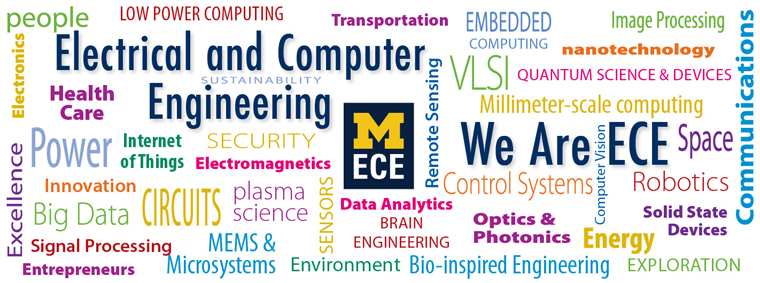We are now one ECE: the merged graduate program in Electrical and Computer Engineering
In recognition of how the Electrical Engineering discipline has evolved, the two graduate programs, Electrical Engineering and Electrical Engineering: Systems, have merged to form one graduate program: Electrical and Computer Engineering.

 Enlarge
Enlarge
Welcome to ECE 2.0
Electrical engineering has always been about innovation. It’s built into the very fabric of the discipline. In recognition of how the Electrical Engineering discipline has evolved, and to better reflect Electrical and Computer Engineering (ECE) at the University of Michigan, the two graduate programs: Electrical Engineering (EE) and Electrical Engineering:Systems (EE:S) have merged to form one graduate program: Electrical and Computer Engineering.
The change was approved by the Rackham Graduate School on April 15, 2015. Students will apply to the newly-merged program beginning Fall 2015.
ECE: A Reflection of the World
“Our students forge their careers in the multidisciplinary world of electronics, computers, and engineering sciences dealing with areas such as communications, data processing, optics, and the Internet of Things, etc.” said Khalil Najafi, Schlumberger Professor of Engineering and Chair of Electrical and Computer Engineering. “We provide the training to take them wherever they need to go. It is time our graduate program reflected this reality.”
“Employers are looking for an integration of electrical and computer components,” said Prof. Raj Nadakuditi, a member of the committee that worked out the details of the new program. “For example, one of the big selling points of the iPhone is the camera. In some parts of the country you can see billboards of images taken by the iPhone. This takes advanced electronics, image processing, low power operation – work that goes on in ECE.”
Modern smart phones also incorporate touch screen interfaces, high quality displays, GPS devices, sensors, and voice activation. They require processing of sound, photos, videos, and text – all technology developed in ECE. This single new degree will reflect the integrated and interdisciplinary nature of modern electronics.
ECE faculty believe the new program will help expand their own knowledge of the discipline. For example, by being able to sit in on a wider array of thesis defenses, they will gain a greater understanding of those research specialties, and discover news ways to collaborate.
“I am co-advising a student with Prof. Zhengya Zhang, who combines VLSI circuit design with signal processing” said Prof. Jeff Fessler, a signal and image processing expert who chaired the committee that worked on the new program. “Zhengya’s students are building circuits with algorithms in them. Also, Yogesh [Prof. Gianchandani] was recently showing me a biomedical sensor that needed signal processing incorporated into it. We should have more students doing this kind of thing.”
Students will no longer have to choose between two programs in ECE.
“We have faculty specializing in embedded systems in both of our former programs,” Prof. Fessler continued. “Power & energy is a field that reaches deeply into both EE and EE:S. At the same time, we have faculty who are experts and leaders in data science, machine learning, and computer vision. Students can now move freely between all the different areas in ECE and learn from each other more easily than they could before.”
Flexibility, Adaptability, and an Interconnected World
“I really see this as an evolutionary change, and not a revolutionary change,” said Prof. Fessler.
The EE degree was part of the original Department of Electrical Engineering, and EE:S was added in 1984 when the Computer, Information and Control Engineering (CICE) graduate program was merged with the existing ECE Department to form the new EECS Department. ECE is very familiar with changing program names.
“Our two prior programs served their purpose perfectly,” said Prof. Najafi. “They established a very strong reputation for Michigan and reflected organizational changes that were happening at the time. But now, with research areas becoming increasingly diverse and interdisciplinary, it is time to combine forces.”
The new ECE program includes more areas of concentration at the Master’s level, while completely removing distinct areas of concentration at the PhD level. Doctoral students have the freedom to fashion their own major area of concentration along with their advisor without having to select courses from a predetermined list of specialties.
“Our faculty, as well as the faculty we are hiring, do a lot of interdisciplinary work, and it makes sense that many of the students we want to train will also have an interdisciplinary focus,” said Prof. Nadakuditi.
Current and new students who want to switch to the new degree program can do that, though the details are still being worked out.
Prof. Fessler noted that “ECE faculty collaborate with faculty and advise students in materials science, mechanical engineering, nuclear engineering, the medical school, statistics, physics, and ecology & evolutionary biology, to name a few. Allowing students to move freely within disciplines is one of the many strengths of Michigan.”
Prof. Najafi has been chair of ECE since 2008, a faculty member since 1988, and is himself an alumnus of the department. He stated:
I have always seen ECE as a unified group, and I believe we are stronger when we break down any barriers to collaboration, no matter how small they may be. This is a small change in our program, but a very important one.
Highlights of the new program
Master’s
Greater flexibility in courses
Expanded research specialties:
– Applied Electromagnetics &
RF Circuits
– Communications
– Computer Vision
– Control Systems
– Embedded systems
– Integrated Circuits & VLSI
– MEMS & Microsystems
– Optics & Photonics
– Power/Energy
– Robotics
– Signal & Image Processing
and Machine Learning
– Solid State & Nanotechnology
PhD
Greater flexibility in courses
Streamlined path to candidacy
Single qualifying exam
Research specialty is determined with advisor. There are no prescribed specialty areas.
Current Students
Incoming and some current students will be able to switch to the new program. Details will be available later this summer.
 MENU
MENU